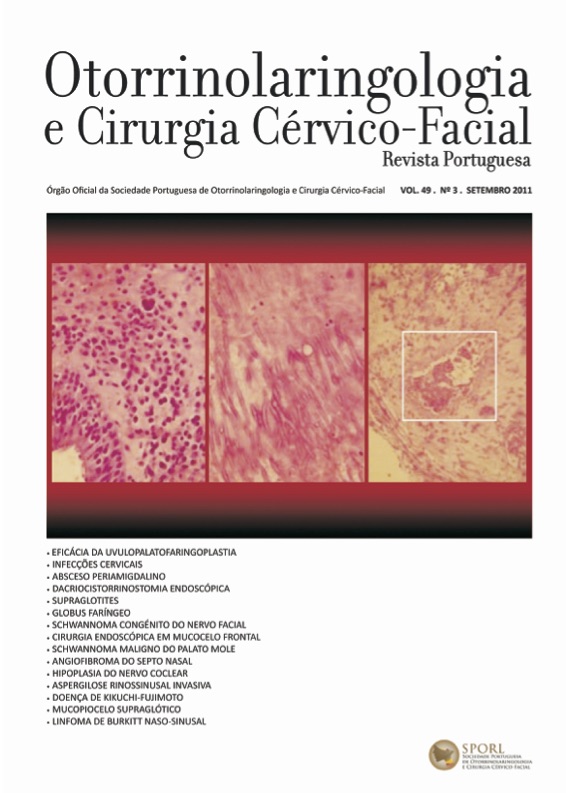Peritonsillar abscess: Incidence and current management
DOI:
https://doi.org/10.34631/sporl.173Keywords:
tonsillitis, abscess, protocolAbstract
Introduction: Peritonsillar abscesses are the commonest deep neck infections and are associated with significant morbidity despite the current use o antibiotics.
Material and methods: Retrospective study of 198 patients with peritonsillar abscesses diagnosed between 2004 and 2010.
Results: The incidence varied between 21 and 37 cases per year with a majority of 106 males, in the total. Ages ranged from 11 to 76 years-old patients and 51,5% of cases had positive history of alcohol consumption or tobacco smoking. Bacteriology showed a predominance of Group A beta-haemolytic Streptococcus and Stahphylococcus aureus.
Conclusions: From this study it is recommended that a management protocol, coverage to both aerobic and anaerobic agents should be implemented, as well as it seems not necessary to routinely harvest pus for microbiological tests.
Downloads
References
Healy C. Peritonsillar abscess. En: Ferri FF, ed. Ferri’s Clinical Advisor 2011. Philadelphia, Pa: Mosby Elsevier; 2010: section 1.
Galioto NJ. Peritonsillar Abscess. Am Fam Physician. 2008;77(2):199–202.
O´Handley JG, Tobin E, Tagge B. Clinical Features of Peritonsillar Abscess. En: Rakel: Textbook of Family Medicine, 7th ed. Philadelphia, Pa: Sounders Elsevier; 2007.
Roberts JR, Hedges JR. Diagnosis of Peritonsillar Abscess. En: Clinical Procedures in Emergency Medicine, 5th ed. Philadelphia, Pa: Sounders Elsevier; 2010.
Shirley WP, Woolley AL, Wiatrak, BJ. Management of Peritonsillar Abscess. En: Flint: Cummings Otolaryngology: Head & Neck Surgery, 5th ed. Philadelphia, Pa: Mosby Elsevier; 2010.
Schwartz RH. Complications of Peritonsillar Abscess. En: Long: Principles and Practice of Pediatric Infectious Diseases Revised Reprint, 3rd ed. Philadelphia, Pa: Churchill Livingstone; 2009.
Johnson RF, et al: An evidence-based review of the treatment of peritonsillar abscess. Otolaryngol Head Neck Surg. 2003;128(3):332-343.
Stringer SP, Schaefer SD, Close, LG. A randomized trial for outpatient management of peritonsillar abscess. Arch Otolaryngol Head Neck Surg 1988;114,296-298.
Maharaj D, Rajah V, Hemsley S. Management of peritonsillar abscess. J Laryngol Otol 1991;105,743-745.
Herzon FS. Peritonsillar abscess: incidence, current management practice, and a proposal for treatment guidelines. Laryngoscope 1995;105(Suppl. 74),1-17.
Al Yaghchi C, Cruise A, Kapoor K, Singh A, Harcourt J. Out-patient management of patients with a peritonsillar abscess. Clin Otolaryngol. 2008; 33(1):52-55.
Ozbek C, Aygenc E, Tuna EU, Selcuk A, Ozdem C. Use of steroids in the treatment of peritonsillar abscess. J Laryngol Otol. 2004;118(6):439-442.






